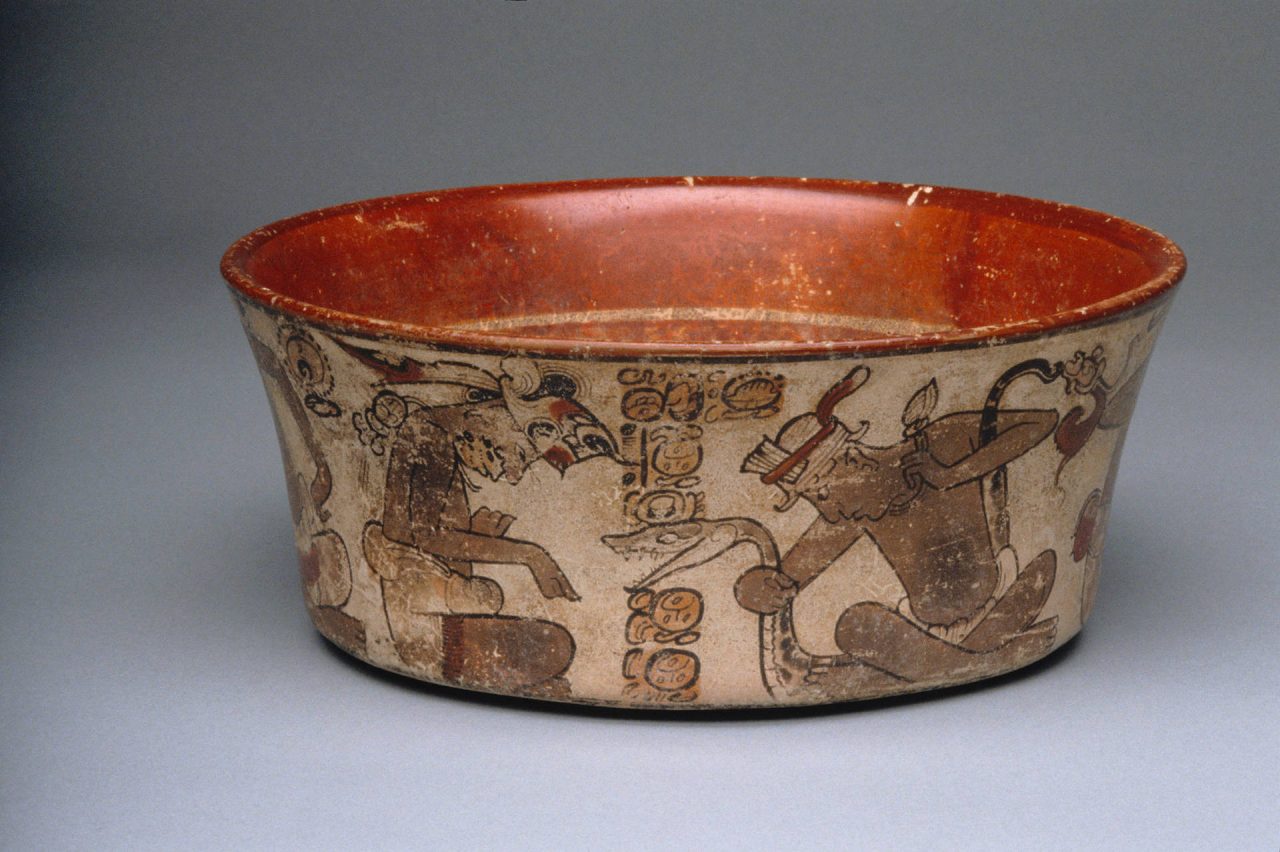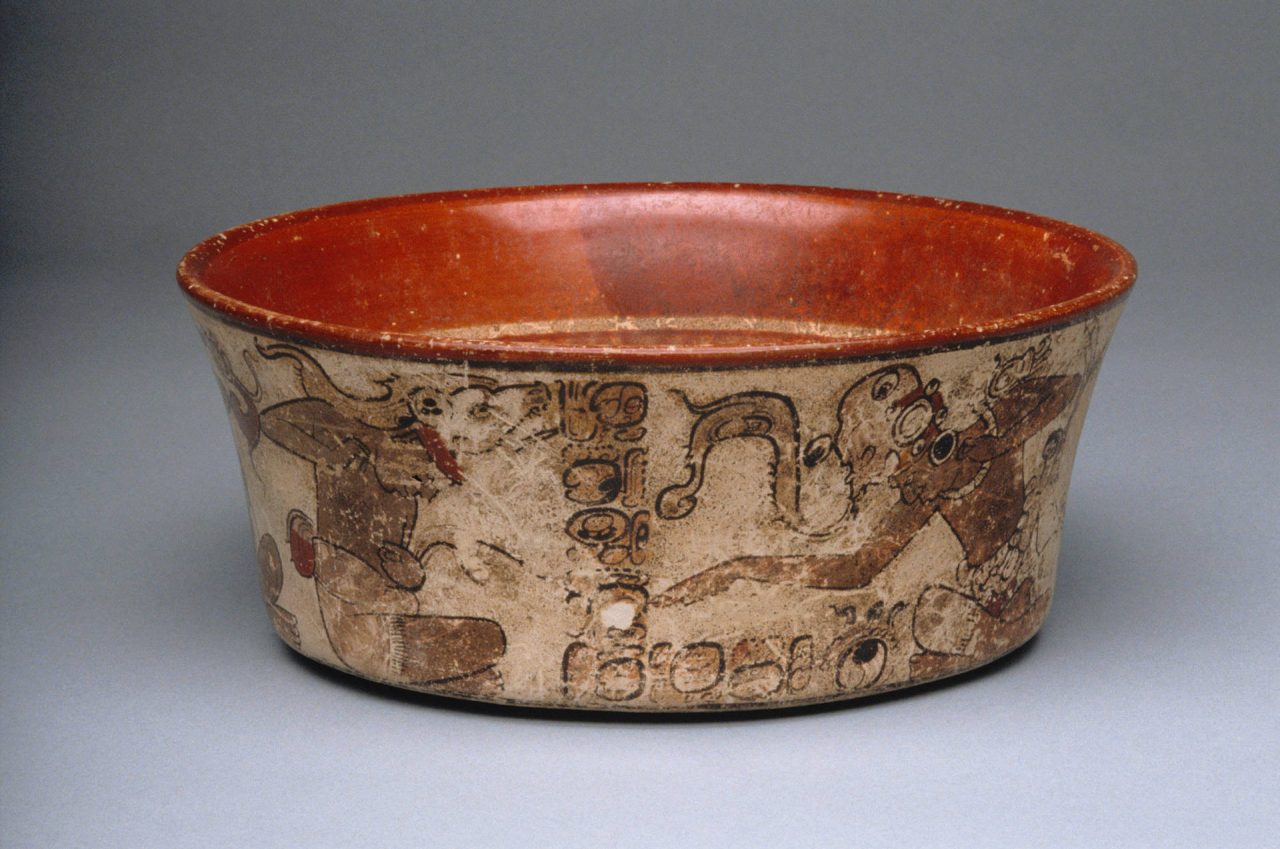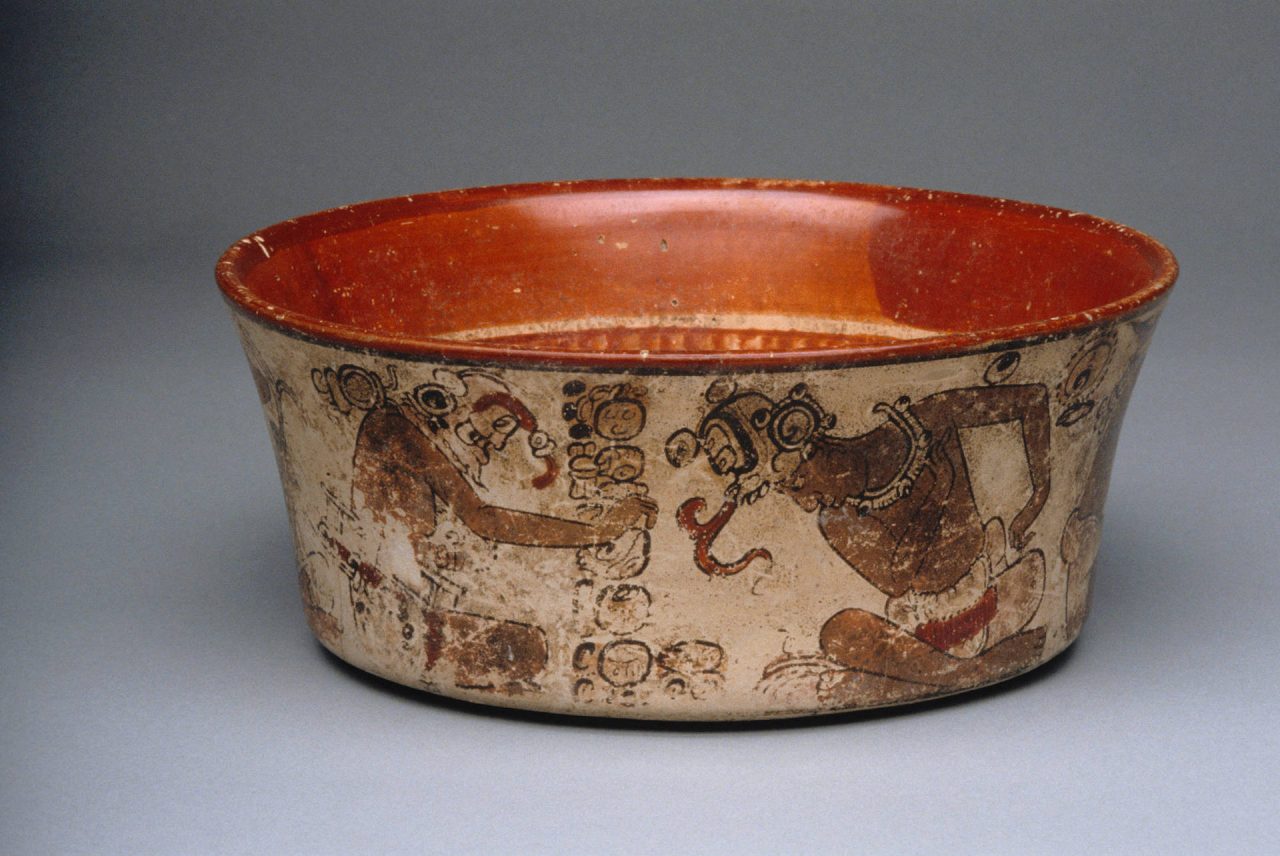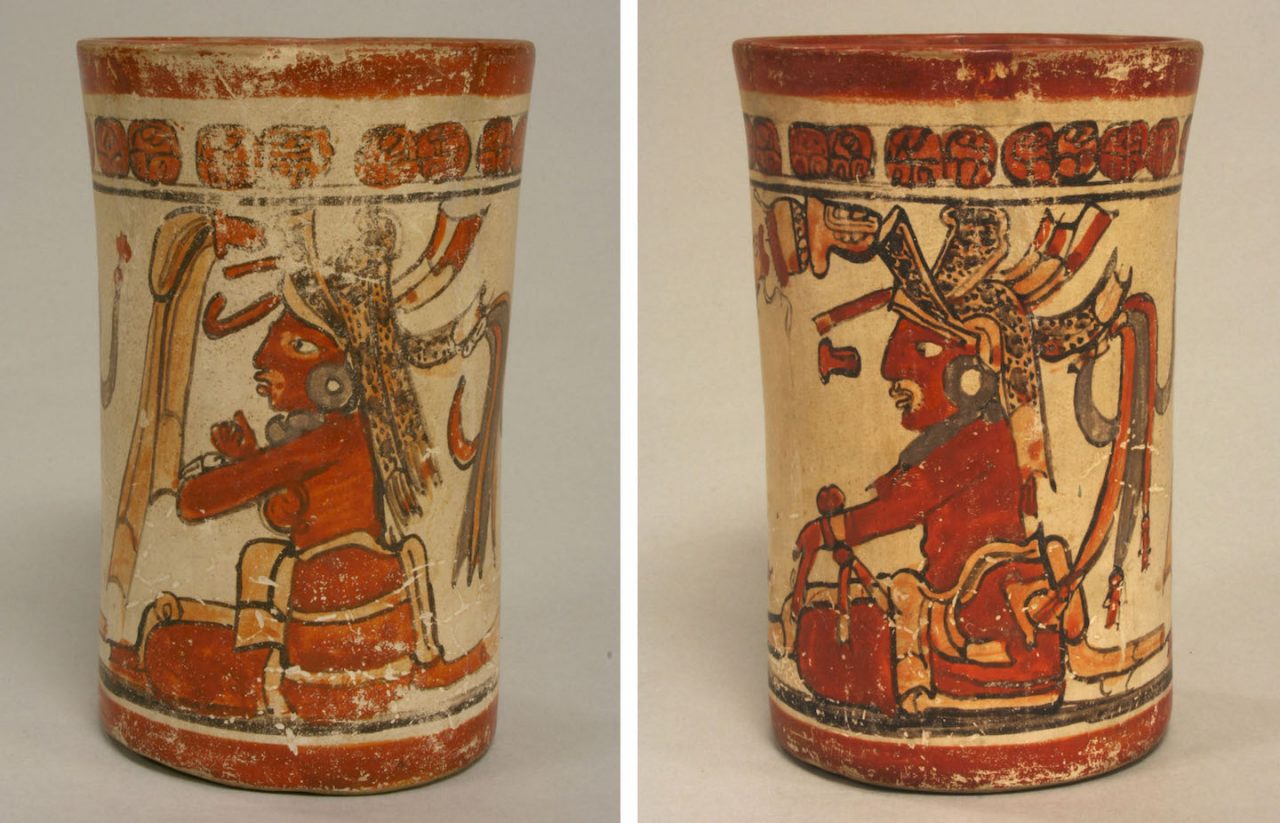Hand Gestures / Rituals



J_Hand Gestures/Rituals 1
Late Classic polychrome bowl, forming part of a three-piece service set belonging to Mo?-n Buluch Laj, animating intense interactions between two seated figures.
Six seated figures, as three pairs, face each other in conversation. They represent two individuals in different stages of transformation, activated by rotation of the bowl; movement is portrayed by alterations in the figures’ headdresses and posture. Arm actions are highlighted through their juxtaposition with the figures’ static posture. Individual 1 (to viewer’s right) thrusts his right arm forward to replicate the shape of the serpent he held in the previous scene. In his third depiction, Individual 1 pulls his arm back to rest his right hand against his heart and left hand above his hip, distrustful of actions performed by the figure opposite (Individual 2; to viewer’s left). The serpent head of the first scene breaks the vertical hieroglyphic text separating all three of the pair’s depictions, replicated by Individual 1’s outstretched hand in the second scene and, in the final scene, by Individual 2 pushing his palm on the central glyph within the vertical text. Individual 2 initially holds his outstretched hand in front of the open snake maw in an oblatory gesture, then recoils, as if bitten, pulling his hand sharply back and up to his chin. Finally, Individual 2 once again advances to rest his hand on the central cartouche of the vertical text. Consequently, the two figures perform a rocking motion illustrating power reversal.
Animation extracted and adapted from vessel no 33754. Courtesy of Princeton University Art Museum; purchase, Fowler McCormick, Class of 1921.
See also Just 2012:138-142, figs. 72-74 for images of the remaining two vessels in this ceramic set.
J_Hand Gestures/Rituals 2
Late Classic Maya cylinder vase that, on rotation in the viewer’s hands, animates a seated figure to turn and lift his outstretched right palm into an upright position and adopt a gesture involving him pressing together his index finger and thumb, while simultaneously stretching his remaining digits vertically into the air. The distinctive hand gesture represents an instructive gesture aimed at an unseen audience, possibly the original owner of the Maya cup (see Santa Rita section in Maya Gods of Time for more information on this hand gesture).
In order to represent the gesture as clearly as possible – and to provide an uninterrupted view of its most important features – the Maya artist chose to ignore the correct physiognomy of human hands and painted the figure’s index finger and thumb on the wrong side of his hand.
Animation extracted and adapted from vessel no 32425. Late Classic Cylinder vase, A.D. 600-800; reddish brown ceramic, buff slip exterior, decoration in brown slip-paint exterior burnished except for centre of base; h. 15.2 cm., diam. 20.4 cm. (6 x 8 1/16 in.); gift of Leonard H. Bernheim Jr., Class of 1959; y1979-65. Courtesy of Princeton University Art Museum.
J_Hand Gestures/Rituals 3
Late Classic Maya cylinder vase, which, on rotation in the viewer’s hands, enlivens the animated conversation of a ruler. The ruler leans forward while gesturing with open palms towards his unseen companion(s), causing his headdress feathers and loincloth to shift positions.
Animation extracted and adapted from vessel no. 31390. Late Classic Maya Cylinder vessel depicting a seated noblemen on each side, A.D. 600-800. Ceramic with polychrome slip, h. 12.3 cm., diam. 10cm. (4 13/16 x 3 15/16 in.); gift of Gillet G. Griffin; y1969-101. Courtesy of Princeton University Art Museum.
J_Hand Gestures/Rituals 4
Details of a Classic period polychrome vase from Guatemala, painted in the Naranjo style, animating on rotation a winged deity with jaguar features to lift and lower his paws. The deity sits cross-legged on a jaguar-pelt throne-cushion, while his head position, tilted back, and open mouth suggest singing or chanting. The space surrounding the figure on the vase is entirely filled with many scrolls and ovals, lending the scene a crowded, ‘noisy’ feel.
Animation extracted and adapted from vessel DP-13003-007. Courtesy of the Metropolitan Museum of Art; The Michael C. Rockefeller Memorial Collection, Purchase, Mrs. Gertrud A. Mellon Gift, 1967.
J_Hand Gestures/Rituals 5
Details of the Early Classic incised Berlin Tripod Vase showing three mourners standing either side of a funerary platform, which, on rotation, enables the lord’s rebirth as an ‘ancestor tree’ (see Maya Gods of Time, fig. 5.20 [view 4]). Turning of the vessel animates the mourners’ sequential, grieving hand movements. Wichmann and Nielson (2016:292-293) first noted how the two scenes tell a (broad) sequential story, that of the lord’s death and burial resulting in his resurrection as an ancestor tree. We add that rotation of the vessel brings the mourners’ grief to life and is the key in activating the time driving this change in events.
Animation extracted and adapted from Schele Drawing IMG0049/5503, http://research.famsi.org/schele.html, and Eberl 2012:312, fig. 492.
J_Hand Gestures/Rituals 6
Details of a Classic period Maya polychrome vase; on rotation, an attendant passes a spherical object to an enthroned deity. The movement is emphasised by the attendant’s headband cloth falling from above his head in his first representation, down his back in the second (following the slightest tilt of his head) and flowing away from his head in the third. The spherical object he holds, probably a stone, takes the position of the central glyph in the vertical text separating assistant and deity, underscoring the importance of the object and his movement.
Animation extracted and adapted from Robicsek and Hales 1981:57, Vessel 68.
J_Hand Gestures/Rituals 7
Details of a Classic period tripod vase from the Peten vicinity of Guatemala. As the ceramic is turned, a figure is animated in ‘three’ to lean towards and converse with a royal figure seated opposite.
Animation extracted and adapted from Robicsek and Hales 1981:177, vessel 153.

J_Hand Gestures/Rituals 8
Late Classic period Maya vase from Yucatan, Mexico, which on rotation animates a seated royal figure to lower his left arm, initially held crossed across his chest.
Simultaneously, the royal’s movement causes the feathers of his headdress to sway, while the cloth bands hanging from the front of his headdress in his first depiction transform into a flower bud nibbled by a fish (slightly obscured in photo).
Animation extracted and adapted from vessel accession no 1978.412.202. Courtesy of the Metropolitan Museum of Art; The Michael C. Rockefeller Memorial Collection, Purchase, Nelson A. Rockefeller Gift, 1967.
J_Hand Gestures/Rituals 9
Classic Maya ‘animation’ demonstrating how, on rotation of the polychrome ceramic, a shoulder shrug is animated between two almost-identically represented kneeling attendants in response to their interactions with an enthroned lord wearing a large IK’ pendant.
Animation extracted and adapted from Kerr 2000:988, file no. 7183.
J_Hand Gestures/Rituals 10
Classic Maya vase animating the subtle ritual interaction between two standing nobles. On rotation of the ceramic, the lady looks up from their hands – initially forming a circle by the pair’s touching thumbs and lady’s middle finger – while straightening her right palm upwards to copy the hand gesture adopted by the man in his first representation and who has now straightened all his fingers.
Animation extracted and adapted from Kerr 1992:477, file no. 4356.
J_Hand Gestures/Rituals 11
Incised cylinder vase from the Montagua Valley animating, on rotation, a seated individual to raise and lower a bundle he holds before his face.
Animation extracted and adapted from Wichmann and Nielsen 2016:291, fig. 11.2c, K2702.
J_Hand Gestures/Rituals 12
Carved Maya tripod bowl animating a seated figure to raise his outstretched arms while two intertwining serpents wrap around his person.
During the animation, the serpent, initially wrapped around his right arm, drops to beside his right hip, while the serpent, initially at his left hip, is now intertwined around his left arm.
Animation extracted and adapted from Kerr 1992:444, file no. 3862.
J_Hand Gestures/Rituals 13
Carved Maya tripod vase animating a figure holding a large bicephalic water-serpent bar to rise from a squatting position. As the figure rises, the serpent heads simultaneously swell in size.
Animation extracted and adapted from Kerr 1994:542, file no. 4465.
J_Hand Gestures/Rituals 14
Polychrome Maya vase animating a seated figure, initially holding a cup, to perform a sweeping gesture with his arm while turning his torso to face the viewer.
Animation extracted and adapted from Kerr 1994:606, file no. 4905.
J_Hand Gestures/Rituals 15
Carved Maya vase animating a seated figure holding a serpent in his lap to grip its neck, turn from looking to his right to his left, then lean back and look up while speaking or exhaling, indicated by and elongated ‘bubble’ emanating from his mouth.
Simultaneously, he raises the serpent head held in his right hand and three ‘bubbles’ now flow upwards from his mouth. Held in the area of his penis, the serpent is comparable to an erection, which is likely to refer to his ‘seed’ promoting birth and growth.
Animation extracted and adapted from Kerr 1994:605, file no. 4901.
J_Hand Gestures/Rituals 16
Details of a Classic period cylinder vase that, when rotated in the viewer’s hands, animates a figure with netted headdress and supernatural traits to lift a mirror to his face. The mirror must reveal something shocking or of great importance, as, after peering at its surface with great concentration, the figure raises his head in surprise, eyes wide; simultaneously, the beak the figure initially exhibited is now replaced by a more humanoid-looking nose.
Animation extracted and adapted from Robicsek and Hales 1981:136, fig. 40a.